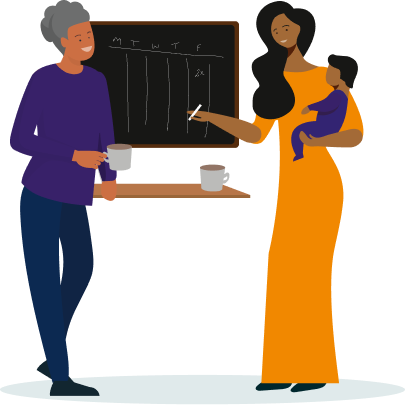SHARE
Social Support
What are activities of daily living (ADLs)?
The activities of daily living (ADLs) is a term used to describe fundamental skills required to independently care for oneself, such as eating, bathing, and mobility. ADLs are an indicator of a person’s functional status. The inability to perform ADLs results in the dependence on other individuals and/or mechanical devices. ADLs are classified into basic ADLs and instrumental ADLs.1
Basic ADLs include1:
- Walking independently
- Ability to feed oneself
- Dressing
- Maintaining personal hygiene
- Controlling bladder and bowel function
- Toileting
Instrumental ADLs include1:
- Transportation and shopping
- Managing finances
- Meal preparation
- Housecleaning and home maintenance
- Communicating with others
- Managing medications

It is important to identify your community of support, including those who can help with ADLs when you need assistance. Your community of support can include family members, friends, caregivers, co-workers, your healthcare team, and other people living with epilepsy.

Sharing your seizure diagnosis
Sharing your seizure diagnosis may not be easy. However, it is important to identify your community of support, including those who can help when you need assistance.
Concerns about disclosing
Maintaining Relationships
“I was embarrassed. I thought that he might not love me anymore or he’d be scared of me.”
Managing Reactions
“I don’t want to frighten them, so I think I need them to know. I want them to know.”
Managing Personal Safety
“It’s absolutely vital that people know in case something happens—for my sake and for theirs.”

Who to tell and when?
“If you’re going to be visiting somewhere regularly, try and find the one person to let them know.”
Opportunities for telling
Waiting for Opportunities
“Bring it up if there’s any mention of it or at a convenient time.”
Using Opportunities
“When someone asks me about the medication and not driving—those are ideal opportunities to tell people.”
Creating Opportunities
"I had to take tablets...when he asked, I broke it in: ‘Well, I'm on these because I have epilepsy.’"

Moment of disclosure
Structuring the message by providing: (1) Factual information (2) Reassurance (3) What to do (4) Gauging reactions (5) Answering questions.
Tailoring your message to audience needs
“I have a matter to mention to you. I have epilepsy…I may experience an occasional seizure. It’s nothing to be concerned about, it can easily be controlled, and there are procedures we can follow if I do have a seizure. I can bring you information about epilepsy, as well as details about the procedures to follow and my contacts.”
You can find additional information with regards to disclosing epilepsy to employers at https://www.epilepsy.com/lifestyle/employment/disclosing-epilepsy
“By the way, I’m on medication for epilepsy, but it’s under control. I just thought I’d let you know.”
“I’m on medication for epilepsy. I’m not embarrassed about it, I just thought I should tell you.”
Brief them on the basics to reassure them there is nothing to be scared of. “If you see me staring a lot or think I’m unwell, please get an adult.”
You can manage reactions by making it ordinary. Keeping it casual, educating about your epilepsy, telling preemptively, and using humor. The information provided in this section is from the following source: Elliott N, Pembroke S, Quirke M, Pender N, Higgins A. Disclosure strategies in adults with epilepsy when telling, "I have epilepsy": The How2tell study. Epilepsia. 2019;60(10):2048-2059. doi: 10.1111/epi.16338
Reference:
- Edemekong PF, Bomgaars DL, Sukumaran S, Schoo C. Activities of Daily Living. In: StatPearls. Treasure Island, FL: StatPearls Publishing; 2025. Updated May 4, 2025. Accessed June 5, 2025. https://www.ncbi.nlm.nih.gov/books/NBK470404/#

